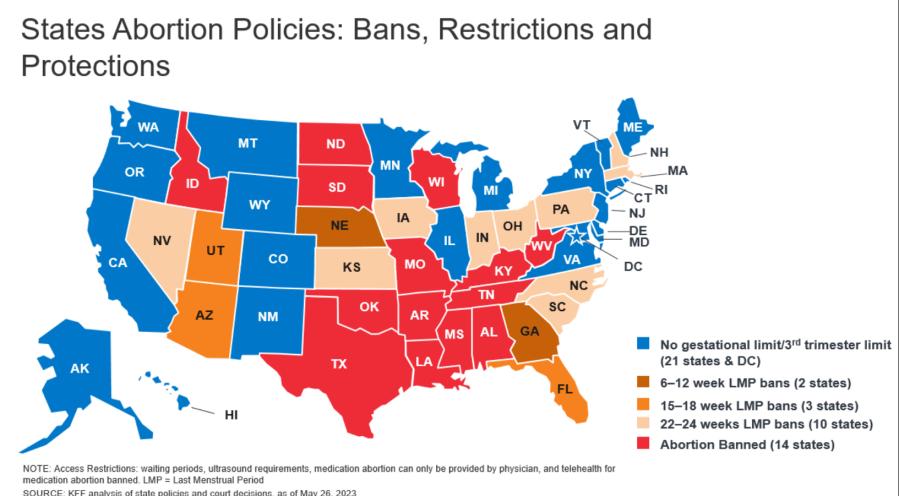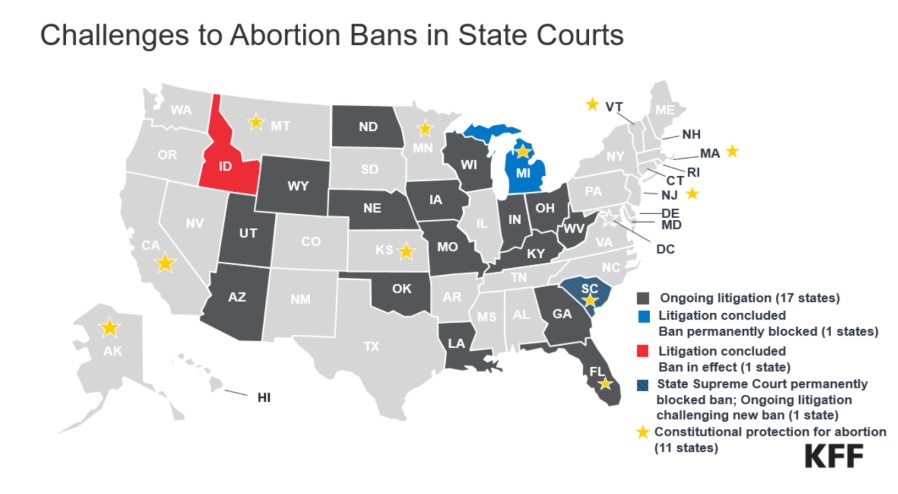Where abortion access stands across the US 1 year after Dobbs
- Trigger laws and new restrictions on abortion took effect after Roe v. Wade
- Other states moved quickly to codify abortion access and protect providers
- Litigation is ongoing in several states, where access is subject to change

FILE – An unoccupied recovery area, left, and an abortion procedure room are seen at a Planned Parenthood Arizona facility in Tempe, Ariz., on June 30, 2022. On Friday, Dec. 30, 2022, the Arizona Court of Appeals concluded that abortion doctors can’t be prosecuted under a pre-statehood law that criminalizes nearly all abortions. The law had been blocked from being enforced shortly after the U.S. Supreme Court issued its 1973 Roe v. Wade decision. But after the Supreme Court overturned the landmark decision in June, Attorney General Mark Brnovich asked a state judge to allow the law to be implemented. (AP Photo/Matt York, File)
Testing on staging11
(NewsNation) — One year since the overturning of Roe v. Wade, a landscape of shifting restrictions and protections of abortion access are increasingly hard to navigate.
As of June 8, abortion was banned in 14 states and protected in 11 state constitutions. The fate of access is still argued through ongoing litigation in 17 states, and policies surrounding gestational limits and penalties vary across state lines.
Whether access is protected or restricted, the effects are far-reaching, said Gretchen E. Ely, a professor and the Ph.D. program director at the University of Tennessee, Knoxville.
“It’s not just a Republican or Democrat issue,” Ely said. “Everybody is impacted by sexual health care generally — not just abortion.”
The U.S. Supreme Court overturned the landmark Roe v. Wade case on June 24, 2023, ending constitutional protections for abortion that had been in place for nearly 50 years.
In the wake of the decision, some states moved quickly to restrict access or effectively ban abortion altogether, penalizing anyone who helped another person secure the procedure and, in some cases, making it a criminal act for doctors to provide them.
“Issues of interstate fighting, for lack of a better word, have yet to ripen completely, said Laurie Sobel, an associate director of the Women’s Health Policy team at KFF. “And we don’t know yet exactly how those are going to play out.”
Among the states with some of the most restrictive abortion policies, post-Roe, are:
- Idaho
- North Dakota
- South Dakota
- Missouri
- Oklahoma
- Texas
- Louisiana
- Mississippi
- Alabama
- Tennessee
- Kentucky
- West Virginia
- Arizona
That’s according to data compiled by the sexual and reproductive health non-profit Guttmacher Institute, which has closely tracked state policy changes that impact abortion access.
In most cases where abortion is restricted or banned, it’s the providers – not the patients – that risk prosecution.
Confusion over those policies has, in some instances, delayed care for people experiencing miscarriages.
Shortly after the Supreme Court’s ruling, a study found the majority of people surveyed from Oklahoma hospitals couldn’t provide clear information about procedures or policies to people who needed an abortion to save a pregnant person’s life.
Policies bolstering the safety of pregnancy and childbirth haven’t always followed behind restrictions, either, Ely said.
“The outcomes for maternal and child health tend to be worse in the states with the most restrictive abortion laws, and better in the states that have more liberal abortion laws,” Ely said.
Many of those states with more liberal laws moved to shore up abortion access when Roe was upended.

New York was one of several states to amend its constitution to codify abortion rights. Others, like Illinois, enacted shield laws to protect abortion providers and patients from out-of-state investigations. In Oregon, private insurance plans are required to cover abortions, which can be provided by qualified healthcare workers, not just physicians.
Guttmacher Institute classifies Oregon as the state where abortion rights are most protected, followed by California, New Mexico, and Vermont in no particular order.
Those standings are subject to change with time and political influence, however.
For example, state constitutional protections for abortion access exist in California, Montana, Kansas, Minnesota, Vermont, Massachusetts, New Jersey, South Carolina, Alaska, and Florida – for now.
Ongoing challenges or proposed restrictions exist in both Florida and South Carolina.

In January, the South Carolina Supreme Court said the state’s constitution included the right to an abortion. That resulted in striking down a ban on the procedure after about six weeks of pregnancy.
The lead author of that decision, however, retired the following month. Now a ban on abortion after 12 weeks is set to take effect July 1. Abortion rights advocates are trying to block it.
It’s just one example of the fast-changing nature of abortion laws post-Roe, and Sobel doesn’t expect it to slow down anytime soon.
“Along with legislators changing, when the composition of a state Supreme Court changes, we’re probably going to see new activity as well, on both sides,” she said.
Some restrictions were already on the books when Roe fell. That includes so-called trigger laws and one from the 1800s that brought into question the legality of the most commonly used method of abortion in the U.S.
Conflicting rulings surrounding the abortion medication mifepristone have only added to the uncertainty felt by advocates both in favor of and opposed to abortion rights.
“The FDA’s role in regulating…drugs that are used for abortion care — where does that end?” Sobel asked. “And where does the state’s roles in regulating abortion start? Where do those two things intersect?”
